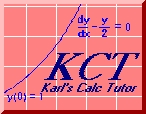

It is believed that the ancient Babylonians were the first to solve problems on which we, today, would apply a quadratic equation. They didn't use the quadratic formula, but rather a method called completing the square. The quadratic formula, though, is simply a formalization of this ancient method.
Suppose you have a quadratic in the form of
ax2 + bx + c = 0 eq. q-1If
c
x = - eq. q-2
b
So we focus on the case where a is nonzero. In this case, we
can divide through by a to get an equivalent quadratic
x2 + px + q = 0 eq. q-3awhere
b
p = eq. q-3b
a
and
c
q = eq. q-3c
a
This simplifies it a little -- we have only two coefficients to worry
about instead of three.
But if only we could massage this into
(x + u)2 - v = 0 eq. q-4then it's simple algebra to add v to both sides, take the square root of both sides, then subtract u from both sides to get
_
x = ± Öv - u eq. q-5
which are the solutions for x. Converting a quadratic into
the form given in eq. q-4 is called completing the square.
What the ancient Babylonians realized is that you can always complete the square in any quadratic of the form given in eq. q-3a. And by doing so, you convert it into the form given in eq. q-4.
To complete the square, you must find expressions in terms of p and q for u and v. In the search for these expressions, you start by multiplying out eq. q-4. What you get is
x2 + 2ux + u2 - v = 0 eq. q-6We can see immediately that the only coefficient of the x term is 2u. In eq. q-3a, the only coefficient of the x term was p. So if it is at all possible to massage eq. q-3a into eq. q-4, then the x term coefficients must be equal, hence it must be true that
2u = p eq. q-7aand therefore
p
u = eq. q-7b
2
You can make the same argument with the constant coefficient (that is the
stuff that is not multiplied by x or x2).
In order for eq. q-3a and eq. q-4 to be the same, their constant coefficients
must be equal. Hence
q = u2 - v eq. q-8aand substituting our newly found expression for u into this we have
p2
q = - v eq. q-8b
4
From this it is easy to write v in terms of
p and q.
p2
v = - q eq. q-9
4
So if you substitute the expressions we now have for u and v
into eq. q-5, which is what we had hoped to use in order to get a solution,
we do indeed get a solution:
æp2 ö p
x = ± sqrtç - q÷ - eq. q-10a
è 4 ø 2
or with a little algebraic munging
_______
± Öp2 - 4q - p
x = eq. q-10b
2
I'll leave it to you to make the substitutions suggested by
If you didn't like that derivation, here's another, starting again with
x2 + px + q = 0 eq. q-3aMake the following substution for x:
p
x = u - eq. q-11
2
So the new quadratic equation is
æ pö2 æ pö
çu - ÷ + pçu - ÷ + q = 0 eq. q-12a
è 2ø è 2ø
When you multiply it out you get
p p2 p
u2 - 2u + + pu - p + q = 0 eq. q-12b
2 4 2
When you take all the cancellations you end up with
p2
u2 - + q = 0 eq. q-12c
4
To solve equation q-12c for u, simply get u2 by itself
on the left. Then u will be plus and minus the square root of the other side. Once you have u,
substitute back to x using Of course this derivation begs the question, "How did you know to make the substitution in equation q-11?" All I can say is that if you walk along the beach long enough you will find a pretty shell or two. One of those shells is that you can eliminate the second-highest power term of any polynomial using a substitution similar to this.
Also see Historical Info on the Solutions to Quadratic, Cubic and Quartic Polynomials.
email me at hahn@netsrq.com